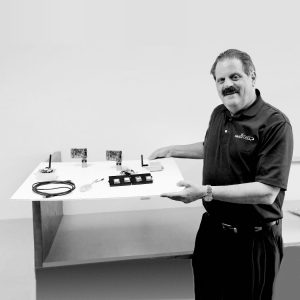
Mark J Heiferling referred to as “Hunter” has slightly over 28 years of experience in data communications, intelligent computing, radio communications, systems integration, product design and IT systems with major firms in the past such as: Wang Labs, Data General, Western Union, Noise Cancellation Technologies, Kindex, and currently Bluetronix Inc. He has been in `“C” level for three firms and VP and a Director of several others. Credentials include: a BA in Economics, Master’s of Science in Technology Management MS, an MBA, a Six Sigma Black Certification, Lean Manufacturing, Kaizen, and QFD-Quality Functional Deployment certifications.
His experiences range from an inventor, manager, SW/HW development, product designer, operations/project manager, entrepreneurial ventures and technology integrations. He has designed over twenty-seven different designed products & services and was one the original innovators of Active Noise Cancellation with a design to synch to engines and machines.
Mr. Heiferling was selected for the Presidential Small Business Commission United States of America award for the State of Ohio by George W Bush. In 2010 he received Defense Advanced Projects Agency (DARPA) Small Business Innovative Success Award for six years of successful R&D for DARPA, and the Defense Dept. He has been involved in renowned world-wide research development in active noise cancellation ANC (one of the founding designers of the ANC algorithms for timing of engine using a patented synch), intelligent computing, machine learning, Edge Computing and various forms of ML/AI for communications, IoT, IIoT, and system’s optimization. He is an inventor, entrepreneur, manager, scientist, author, designer, and an adjunct professor. Six-time multiple SBIR Small Business Innovation Research award winner, & two time R&D NASA, Army, AF contract winner. Heavily experienced in project management such as Agile and Scrum.
Vehicle-to-vehicle (V2V) & ‘Vehicle to everything’ V2X Communications Using Unsupervised Reinforcement Learning (through Swarm Intelligence Car manufacturers are now developing systems for Vehicle-to-vehicle (V2V) communications and vehicle-to-everything technology to enable vehicles to communicate with each other and, road infrastructure, including traffic lights, stop signs, road hazards, traffic accidents and traffic congestion. Today with IoT (Internet of Things) 5G, forthcoming 6G, lidar, autonomous vehicles, cloud computing and through the air software updates, 5G and edge-based computing, all these capabilities not too far off from reality. Vehicle-to-vehicle (V2V) communication’s ability to wirelessly share & update information about the speed, location, and position of surrounding vehicles will be coming to all vehicles shortly. This will reduce accidents, ease traffic congestion, and improve the environment.V2X, which stands for ‘vehicle to everything’, is the common term for the car’s communication system, where information from sensors and other sources travels via high-bandwidth, lower-latency, highreliability links, thereby facilitating fully 5G or Dedicated Short-Range Communications (DSRC). The simple idea of a car driven and controlled by computers has a long history, dating back to even the 1950s! However, the last decade has seen government, many manufacturers, and startups join the dream claiming that truly self-driving car that are incorporating advances in artificial intelligence (AI), machine learning (ML) with state-of-the-art sensors. The big dream is that autonomous vehicles will be able to improve upon toady’s drivers with fewer mistakes and abide by traffic laws. This capability will be able to mitigate traffic congestion, and other safety issues, and therefore improve the efficiency of mobility systems seen today. Therefore, this will save energy, reduce pollution, and decrease the time currently lost to driving. Recently manufacturers have been instituting “through the air” capabilities to update vehicle software but also to seek subscription services (new revenues). Cars that improve over time with software update features will increasingly make vehicles more modern safer and competitive. Sometime in the next decade, there is a good chance autonomous driving is likely to become the critical application feature for connected cars. Soon you will be able to request your car to update your location or send it to someone else for retrieval. The recent advent of electric vehicles (EVs) will require connected communications to be autonomous, energy efficient. Connection will be necessary to find charging locations and improve driving dynamics and safety. In order to bring these capabilities to reality we propose to leverage a form of AI that is machine learning referred to as: “Unsupervised Reinforcement Learning (URL) ” is a form of what is known as “Swarm Intelligence” (SI ). This is to be utilized to structure the network, communications and most importantly provide the learning and real time updates to make Vehicle-to-vehicle (V2V) & (V2X) communications possible through decentralized networks (DN). Key Words: Artificial Intelligence (AI), Machine Learning (ML), Mobility Systems, Decentralized Networks (DN), Internet of Things (IoT), Autonomous Systems, Vehicle-to-vehicle (V2V), (V2X) vehicle to everything, Swarm Intelligence (SI) Energy & Mobility Conference & Expo.
The secret to autonomous vehicles and mass adoption
Reduction of energy and increased safety
Connection everything for the future